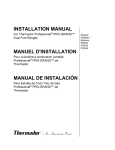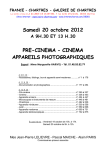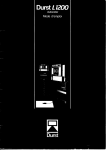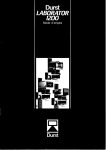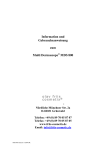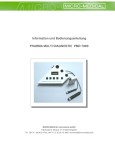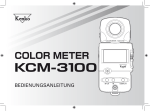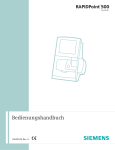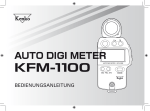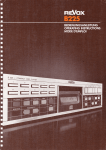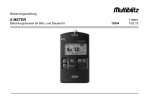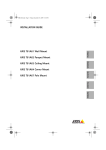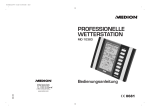Download Untitled
Transcript
lnhaltsverzeichnis
''l. Der PROFI-select
TTL
des Systems
2. Zusammenbau
des PROFI-select
2.1 Verwendung
TTL mit der Messkassette
des PROFI-select
2.2 Verwendung
TTL mit der SINAR-Messrückwand
Dauerlichtmessung
3.
4.
Blitzlichtmessung
Mischlichtmessung
5.
Kontrastmessung
6.
und
7. SelektiveBelichtungsKontraststeuerung
7.1 RichtigeWahlder Messstelle
7.2 Mittelwertmessung
ag
u fh e l l s t e
7.3 1-Punkt-Messun
Bildstelle
7.4 2-Punkt-Messung
7.5 Kontrastbewältigung
B. Kurzanleitung
ln den USA ist der PROFISIXunter
dem NamenLUNA-prosbc bekannt.
Contents
1.
Z.
z.l
2.2
4.
5.
6.
7.
7.1
7.2
7.3
7.4
7.5
8.
TTL
The PROFI-select
Assembling
the system
TTL
Usingthe PROFI-select
withthe lightmetercassette
TTL
Usingthe PROFI-select
withthe SINARmeteringback
readings
Continuous-light
Flashreadings
readings
Mixed-light
Contrastreadings
Selectiveexposureand contrast
control
Selectingthe correctreading
point
Midpointreadings
S i n g l e - p o i nh ti g h l i g h t r e a d i n g s
Two-pointreadings
Copingwithcontrast
Instructions
in brief
Sommaire
1.
z.
z. l
2.2
3.
A
5.
7.
7.1
7.2
7.3
7.4
7.5
8.
i s k n o w na s
I n t h e U S A ,P R O F I S I X
LUNA-prosbc.
TTL
Le PROFI-select
Structuredu systöme
TTL
Utilisation
du PROFI-select
avec chässisoorte-sonde
TTL
Utilisation
du PROFI-select
avecle dos de mesureSINAR
Mesurede la lumiÖrecontinue
Mesurede l'6clairageau flash
Mesureen lumiöremixte
Mesuredu contraste
Mesures6lectivede l'6clairaqe
et du contraste
Bienchoisirla partiedu sujet
ä mesurer
Mesurede la valeurmoyenne
Mesuredansla partiela plus
clairede I'image
Mesurepar la m6thodedes deux
ooints
Maitrisedu contraste
Moded'emploisuccinct
Aux Etats-Unis,PROFISIXest connu
sousle nom de LUNA-prosbc.
)
, )/
P R OFISIX
&
,
3
5
o
15
18
8
13
25
r
o
1 Dil
m(
2Me
3Mr
4Mr
5Dr
6Me
7 ro1
8Ab
9Ta
10 we
Ve
17
22
23
t I
vg
12 Ös
13 Be
14 Mi
(1/t
TTL
PROFI-select
140 Messkassette
Lightmetercassette
Chässisporte-sonde
15 we
Be
1 6A r
17
18
19
20
21
22
23
24
25
26
27
28
29
30
32
Be
B|
Gz
Etl
für
Eu
Be
Ei
Dr
wt
Ei
qu
m'
üt
ru
Nt
Li
Bi
Ar
9r
130 PI
131At
132 sl
133W
134 M
135 St
136 M
'137 Bt
138 Br
140 M
141 Ki
142 M
143 A
150 H
't51 R
152A
1 Diffusor-Kalotte(für Lichtmessung)
z Messwerkskala
J Messwerk-Nullmarke
4 Messwerkzeiger
Drehrichtungsmarken
Messtaste(rot)
7 roteDreiecksmarken
Ablesemarkef ür Blitzlichtmessung
o Tastef ür Batteriekontrolle
(grün)
f ür
1 0 weisseEinstellmarke
Verlängerungsfaktoren
1 1 Verlängerungsfaktoren
1 2 Ose für Tragleine
( + /-)
1 3 Belichtungswertanpassung
Filmer
t + Markefür professionelle
(t/soSekunde)
für
weisseEinstellmarke
Belichtungswertanpassung
für rotesSignalfeld
t o Abdeckung
1 7 Belichtungszeiten
1 8 Blendenzahlen
fürs Filmen
1 9 Gangzahlen
mit GriffriPPen
2 0 Einstellscheibe
für DIN/ASA-Werte
f ür DlN/ASA-Werte
2 1 Einstellmarke
(Lichtwerte)
z z Belichtungswerte
f ür Einflussgrössen
23 Einstellring
24 Drehring
weisseWahlmarkefür
Einschaltzeit
Markefür Einzel2 6 quadratische
messungmit Speicherübernahme
27 rundeMarkefür Dauermessung
2B Nullstellschraube
29 Lux-undfootcandle-Tabelle
30 Batteriekammer
für Vorsatz32 Anschlussbuchsen
geräte
130 PROFI-selectTTL
für PROFISIX
131 Anschlussstecker
für Blitzlichtmessung
132 Startknopf
133 Wählschalter
134 Messwippe
135 Sondenstab
136 Messfenster
137 Befestigungshebel
138 Befestigungsklammer
140 Messkassette
141 Kassettenschieber
142 Messsondenarretierung
143 Aussparungen
150 Halteplatte
151 Rändelschraube
an der Halteplatte
152 Aussparungen
1 Incidentlightdiffuser
z Indicatorscale
Zeroscaleadjustmentline
A
Indicatorneedle
Directionmarks
Measuringbutton(red)
-7
Redtriangles
Red arrowfor flashreadings
o Buttonfor batterytest (green)
1 0 Whiteindexlinefor extension
factorsetting
11 Extensionfactors
12 Eyeletfor neckstrap
13 Exposurevalue(EV)
modificationscale ( + /-)
14 Readingdot for cinematographers(t/sosecond)
1 5 W h i t ei n d e xl i n ef o r E V
modificationsetting
16 Slidingblackcoverfor red signal
17 Exoosuretime scale
'l 8 Apenurescale (f-stops)
19 Cinescale(framesper second)
20 RibbedASA/DINfilm speed
settingdisk
21 Indexfor ASA/DINsetting
22 Exposurevalue(EV)scale
23 Settingringfor modifiedsettings
24 Computerringfor setting
indicatorneedle
25 Whiteselectorindexfor
duration
measurements
26 Squaresettingmarkfor single
with storage
measurement
27 Roundsettingmarkfor extended
cycle
measurement
,28 Zero scale adjustmentscrew
29 Lux and footcandlescaleequivalents
30 Batterychamber
32 Outletsfor connectionsof accessories
TTL
130 PROFI-select
1 3 1 C o n n e c t i npgl u gf o r t h eP R O F I S I X
132 Start (reset)buttonfor flash
133 Modeselectorswitch
134 Probeswitch
135 Probe
1 3 6 C e l lw i n d o w
137 Lockinglever
1 3 8 R e t a i n i ncgl a m p
140 Lightmetercassette
141 Cassettedarkslide
1 4 2 P r o b el o c k
143 Cutouts
150 Metercarrier
1 5 1 M i l l e ds c r e w
152 Cutoutsfor carrier
1
2
3
4
5
Calottediffusante
Echellede galvanomÖtre
26ro du galvanomÖtre
Aiguilledu galvanomÖtre
Indicateurs
de sensde rotation
de la bague
6 Touchede mesure(rouge)
(rouges)
7 Flepörestriangulaires
8 Indexde lecturepourmesureflash
9 Touchede contrölede pile (verte)
10 Indexblancpourcoefficients
de prolongation
11 Coefficients
de prolongation
12 Boucleoourcordonde cou
13 Correctiond'indicede lumination(+ /-)
(l/sos)
14 Indexpourfilmeursprofessionnels
15 Indexblancpourcorrection
d ' i n d i c ed e l u m i n a t i o n
16 Cachepourplagesignalrouge
17 Tempsd'exposition
18 Ouverturesde diaphragme
19 Cadencespourle cin6ma(images/s)
20 Disqued'affichageDIN/ASA
21 Repöred'affichageDIN/ASA
22 Valeursd'exoosition
23 Bagued'affichagedes corrections
24 Baguetournante
25 Repöreblancde s6lectionde
duröede mesure
2 6 Repörecarröpourmesure
unioueavecmiseen m6moire
:27 Repörerondpourmesure
longueduröe
28 Vis de remiseä z6ro
29 Tableaude conespondanceen
lux et footcandle
30 Logementdes piles
pouradditifs
öz Douillesd'adaptation
TTL
1 3 0 PROFI-select
pour
1 3 1Tigesde raccordement
PROFISIX
132 Boutonde commandePour
mesureflash
de s6lection
133 Commutateur
134 Touchede commande
1 3 5 T i g ed e l a s o n d e
136 FenÖtrede mesure
137 Levierde fixation
138 Attachede fixation
140 Chässisporte-sonde
141 Voletcoulissant
142 Blocagesondede mesure
143 Cavit6s
150 Support
151 Boutoncr6nelö
152 Cavit6sdansle support
1. DerPROFI-select
TTL
1. The PROFI-select
TTL
Der PROFI-selectTTL ergänzt den
The PROF|-selectTTL convertsthe
P R O F I S I Xz u e i n e mB e l i c h t u n g s m e s - PROFISIXintoa viewcameraexoosure
ser für die Fachkamera,mit dem someterforspotreadingsinthefilmplane,
wohlDauerlicht
alsauchBlitzlicht
selek- suitablefor continuouslightas well as
tiv in der Filmebenegemessenwerden f l a s h .
können.
To eliminateanyerrorthePROFI-select
Um alle Unsicherheiten
auszuschlies- TTL reads the light actually in the
sen, misstder PROFI-select
TTL nicht imageplaneand not the imagebrighteinfachdie Mattscheibenhelligkeit,
son- nesson the groundglassscreen.This
dern das tatsächlichin der Filmebene methodautomatically
allowsfor closevorhandeneLicht.Verlängerungsfakto- up and filterfactorsas well as natural
ren, bedingt durch kurze Aufnahme- vignettingwith extreme wide angle
distanzenoderAufnahmefilter,
werden lensesor when the imageis movedup
genausoauto- to the edgeof the lens'sfieldby parallel
mitdiesemMesssystem
matischberücksichtigt
wie der natür- disolacement.
licheLichtabfall
bei extremweitwinkligen To eliminatealso mechanicaliris diaObjektiven
oderbeiVerschiebungen
phragm tolerances and erroneous
bis
an den Randdes Objektivbildkreises. readingsdue to full-aperture
mechaniUm auch die Toleranzender Blenden cal vignetting,the PROFI-selectTTL
mitzumessenund Messfehlerdurch readsattheworkingaperturewhenever
Vignettierungbei geöffneter Blende possible.
auszuschliessen,
wird mitdem PROFI- The main meter adjustmentsare the
select TTL wenn immer möglich bei same as for the basicPROFISIXused
gemessen.
Arbeitsblende
in the normalway. So for film speed
Diewichtigsten
Einstellungen
am Mess- settings,testingand changingthe batsystem geschehengleichwie bei der tery,etc.,pleasereferto the PROFISIX
normalenVerwendung
des PROFISIX- instruction
manual:
Grundgerätes.Für Arbeitenwie Film- Brief pressure on the red measuring
empfindlichkeits-Einstellung,
Batterie- button(6)switcheson thewholeunitfor
kontrolle,Batteriewechselusw. neh- abouthalfa minute.
men Sie bitte die Gebrauchsanleitung For readingslikelyto take longer,lock
zurHand:
d e sP R O F I S I X
out the auto-offswitchby depressing
Ein kurzfristigerDruck auf die Mess- the red measuring button (6) and
taste (6) genügt,um die gesamteGelockingit by a slightturnto the right.The
rätekombination
für etwat/zMinuteeinwhite index (25) is then opposite the
z u s c h a l t e nF. ü r M e s s u n g e nd, i e . l ä n - round mark (27\.
g e r e Z e iilnA n s p r u c h
n e h m e nk, a n nd i e On depressing
the red buttonand turnyou re-engagethe
Abschaltautomatik
ausgeschaltet
wering anticlock-wise
den, indem man die Messfasfe (6) auto-offswitch.
drückt und durch leichte Rechtsdre- After measuring rotate the computer
hung arretiert.Die uzersseWahlmarke ring (24) untilthe indicatorneedle (4) is
(25) steht dann auf der runden Marke o n 0 .
(27).DurchDrückender Messtastemit
In additionto the PROFISIXand the
gleichzeitiger
Linksdrehung
ist die AbPROFI-selectTTL probe attachment
schaltautomatikwieder in Betrieb. you needeithera fittinglightmetercasN a c h d e m M e s s e nP R O F I S I Xn u l l e n , sette - or you can use the exposure
d.h. Drehring(24) drehen,bis Mess- meter withoutcassettedirectlyin the
werkzeiger(4) auf 0 steht.
SINARmeteringback.Lightmeter
casZ u s ä t z l i c hz u m P R O F I S I Xu n d d e m settesfor allinternational
camerabacks
Sondenvorsatzgerät
PROFI-select
TTL
are available.
wird entwedereine zur Fachkamera
passendeMesskassette
benötigt,oder
der Belichtungsmesser
wird ohne zusätzlicheKassettedirektin der SINARMessrückwandverwendet.Messkassetten für alle internationalen
Rückwändesindlieferbar.
1. Le PROFI-selectTTL
Compl6t6avec le PROFI-selectTTL,
PROFISIXdevientun posemötreprofessionnelpermettantd'effectueraussi
bienles mesureslonguedureeque les
m e s u r e sd ' i n t e n s i tdee l ' e c l a i rd a n s l e
o l a nd u f i l m .
Pour 6liminertoute source d'incertitude,PROFI-select
TTL ne se contente
pas de mesurerla lumiöresur le verre
döpoli,maisbienla quantitöde lumiöre
qui est pr6sentedans le plan du film.
Les facteursde prolongation
dus aux
prisesde vues rapprocheesou filtres
pris en compte
sont automatiquement
gräce ä ce systöme,tout comme les
pertes de luminositeavec les trös
grands angulairesou les d6centrementsjusqu'auborddu cercled'image
nette.
Afinde tenircomptedestol6rancesdes
diaphragmeset pour eviterles erreurs
cons6cutivesau vignettage ä diaphragmeouvert,il estconsei116
d'effectuer les mesuresavecle PROFI-select
TTL au diaphragme
de travailä chaque
foisque celaest possible.
Les principauxr6glagesse font de la
m6me fagon que lors de I'utilisation
n o r m a l ed u P R O F I S I Xd e b a s e .P o u r
les questionsconcernantl'affichagede
la sensibilit6du film, le contröleet le
changementdes piles, veuillezvous
reoorterau mode d'emoloidu PROFISIX:
Une courte pression sur la touche de
mesure(6) suffitpour enclencherI'ensemble du systöme pour une dur6e
d'environ30 secondes.Pour les mesures plus longues, d6brayer I'arröt
automatiquede la fagonsuivante:appuyersur latouchede mesure(6) et la
bloquerpar l6görerotationvers la droite.
Le repöre blanc de s6lection (25) se
trouveraafors en face du repöre rond
(27). Pour remettre en circuit I'arröt
appuyersur la touchede
automatique,
mesure en la faisant oivoter vers la
gauche. Aprös mesuragetourner la
bague (24)jusqu'aumomenloü I'aiguille
du galvanomötre(4) se trouvesur 0.
Le PROFISIXet sonadditifPROF|-select
TTL s'utilisentavec un chässisportesondeappropri6ou encoredirectement
dans le dos de mesurede SINAR.Des
chässisporte-sondepourtous les dos
internationaux
sontdisoonibles.
2.
des Systems
Zusammenbau
2.
2.1
Verwendungdes PROFI-selectTTL
mit der Messkassette
S c h u t z b l e n df üerA n s c h l u s s b u c h s e n
2 . 1. 1 A m P R O F I S I X
entfernenund Diffusor-Kalotte(1) in Mittelstellung
schieben.
( 1e3r 8 )d e s
a u fd i e B e f e s t i g u n g s k l a m m
2 . 1. 2 P R O F I S I X
TTL legenund zusammenschieben.
PROFI-select
(138) des PROFI-select
TTL
2.1.3 Befestigungsklammer
in die dafür vorgesehenen Aussparungen
(143)der Messkassefte(140)einschiebenund mit
(137) arretieren.
dem Eefesflgungshebel
(142)lösen.
2.1.4 Messsondenarretierung
lst eine Messkassetteaus frühererLieferungals
Befe1981 vorhanden,so kannin der bevorzugten
TTL die Messdes PROFI-select
stigungsposition
(142) nicht betätigtwerden.In
sondenarretrerung
solchenFällenlässtsich
- d e r P R O F I S I Xn u r i n d e r u m 1 8 0 o g e d r e h t e n
Positionauf der Kassetteeinsetzen,
- durcheine SINAR-Servicestelle
eine modifizierte
einbauen.
Messsondenarretierung
- H e b e l s e l b s t a b f e i l e n ,b i s e r n i c h t m e h r a m
ansteht.
PROFISIX
2.1.5 Messkassetteumdrehen und den Sondenstab
nach unten)in die Kassette
(135) (Firmen-Signet
einschieben.
2.1.6 Die Aussparungan der Messkassettedient der
S I N A R - K a s s e t t e n a u t o m aSt i ke .m u s s b e i m E i n schiebenin die Rückwandlinksuntensein.
2.1
Verwendungdes PROFI-selectTTL
mit der SINAR-Messrückwand
2 . 2 . 1 Z u s a m m e n b awui e u n t e r2 . 1 . 1u n d 2 . 1 . 2b e s c h r i e ben.
(151)am
mittelsRändelschraube
2.2.2 Halteplatte(150)
S n n d p n n e h ä r r sdce r S I N A R - M e s s r ü c k w a o
nd e r
in einerderseitlichenLeistenam Kupplungsrahmen
befestigen.
TTL
(138)des PROFI-select
2.2.3 Befestigungsklammer
in die dafür vorgesehenenAussparungender
Halteplatte(152) einschiebenund mit Eefesfrg ungshebel(137) arretieren.
2.2.4 Sondenstab (135) (Firmen-Signetgegen die
der Messins Sondengehäuse
Kamerarückseite)
an
rückwandeinschieben.Dazu den Arretierhebel
lösen.
Messrückwand
der
vv,,vvr
rYvr
Using the PROFI-selectTTL
with the lightmetercassette
2.1.1 Removethe protectivecover over the accessory
outletson the PROFISIXand pushthe diffuser(1)
to its centreoosition.
2 . 1 . 2 P l a c et h e P R O F I S I Xm e t e ro n t h e P R O F I - s e l e c t
TTL retainingclamp(138)and pushtogether.
2.1.3 Push the retainingclamp (138) of the PROFIselect TTL into the cutouts (143) providedfor it
in thelightmelercasseüe(140)andsecurewiththe
lockinglever (137).
2.1.4 Releasetheprobelock (142).
the probe lock
With pre-1981lightmetercassettes,
(142) cannot be operatedin the preferredfixing
TTL.In thatcase:
oositionof the PROFI-select
- fit the PROFISIXin the cassettereversedthrough
180o,or
- get a SINARservicingstationto installa modified
orobelock.or
- file down the lever yourselfso that it no longer
f o u l st h e P R O F I S I X .
2.1.5 Turn roundthe lightmetercassetteand insertthe
probe (135)- withthe companyemblemfacedown
- intothe cassette.
2.1.6 The cutoutin the lightmetercassetteis part of the
automaticSINARfilmholdercontrol.Wheninserted
in thecamerabackthiscutoutmustbe at the bottom
left.
2.2
2.2
Assemblingthe system
The numbersin bracketsreferto the annotatedillustrationsof the fold-out.
Die Zahlenin Klammernbeziehensich auf die Hinweise
Faltseite.
auf der ausklaopbaren
Using the PROFI-selectTTL
with the SlNAR,meteringback
2.2.1 Assembleas describedin sections2.1.1 and2.1.2.
2 . 2 . 2 W i t ht h e m i l l e ds c r e w( 1 5 1 ) ,s c r e wt h e m e t e rc a r r i e r ( 1 5 0 ) i n t o t h e p r o b e h o u s i n $ ' o ft h e S I N A F
meteringback or into one of the side stripsof the
nnr rnlinn
framo
rssvv
2 . 2 . 3 P u s ht h e r e t a i n i ncgl a m p( 1 3 8 )o f t h e P R O F I - s e l e c t
TTL intothe cutouts(152)providedfor the purpose
in the meter carrierand secure with the locking
lever(137).
2.2.4 Push the probe (135) (withthe companyemblem
facing towardsthe camera back) into the probe
housingof the meteringback.To do this,releasethe
lockingleverin the meteringback.
2.
Structuredu systÖme
concernentles indications
Les chiffresentre parenthÖses
figurantsur la pagerepliee.
2.1
U t i l i s a t i o nd u P R O F I - s e l e cTtT L e n l i a i s o na v e c
le chässis porte-sonde
2.1.1 Enleverle carterde protectiondes douillesd'adaptation du PROFISIXet mettrela calottediffusante(1) en
positionm6diane
2 . 1. 2 P l a c e rl ' a p p a r e idl e b a s e P R O F I S I Xs u r I ' a t t a c h ed e
TTL et emboiter.
fixation(138)du PROFI-select
2.1.g lntroduirel'attachede fixation(138)du PROFI-select
TTL dans les cavifös (143) pr6vuesä cet effet sur
le chässlsporte-sonde(140) et bloquerä l'aide du
levier(137).
2.1.4 Relächerle levierde blocagede la sonde de mesure
( 1 4 2 ) . E nu t i l i s a nut n c h ä s s i sp o r t e - s o n dde' u nm o d Ö l e
a n t 6 r i e uär 1 9 8 1, l e l e v i e rd e b l o c a g ed e l a s o n d ed e
mesure (142) ne peut pas ötre actionn6lorsquele
PROF|-selectTTL est mont6 dans la positionhabituelle.Dansces cas il est possible:
- d e m o n t e lre P R O F I S I X
s u rl e c h ä s s i se n l et o u r n a nät
18 0 0
- de faire monterun levierde blocagemodifi6par les
s o i n sd ' u ns P 6 c i a l i s tSeI N A R
- de limer soi-mÖmele levierde fagon ä ce qu'il ne
t o u c h eP l u sl e P R O F I S I X '
2.1.5 Retournerle chässisporte-sondeet introduirela ftge
de la sonde (135)(siglede la firmevers le bas)dansle
chässis.
sertau
2.1.6 La cavit6se trouvantsur le chässisporte-sonde
automatiqueSINAR.Elle doit se troufonctionnement
dansle dosde
ver en basä gauchelorsde I'introduction
lachambre.
2.2
Pour utiliser le PROFI-selectTTL avec le dos
d e m e s u r eS I N A R
2 . 2 . 1 M o n t a g ec o m m ei n d i q u 6s o u s2 ' 1. 1 e | 2 . 1- 2 2.2.2 A l'aidedu boutoncrönelö(151)fixer le support(150)
s u rl e c h ä s s i sd u d o sd e m e s u r eS I N A Ro u s u rl ' u n ed e s
bordureslat6ralesdu cadre.
2.2.3 lntroduirel'attachede fixation(138)du PROFI-select
TTL dans les cavlfds pr6vues ä cet effet sur le support(152)et bloquerä l'aidedu levier(137).
2.2.4 lntroduirela tige de la sonde (135) (siglede la firme
versle dos de la chambre)dansle chässisporte-sonde
du dos de mesure,en prenantsoin de dÖbloquerle
levierse trouvantsur le dos de mesure.
3.
Dauerlichtmessung
3.
3.1
21/zund
D e rM e s s b e r e i cbhe i2 1 D I Nl i e g tz w i s c h e n
LW/EV.
131/s
FilmempfindlichkeitamPROFlSlXeinstellen.
in die Kamerarückwand
Messkassette
einschieben,
(141)herausziehen
Kasseltenschieber
und Messson d enarretierung (142) lösen.
Sondenstab(135)in die gewünschtePositionbrin(136)an
gen, so dass sich das runde Messfenster
der zu messendenBildstellebefindet.
Messder SINAR-Messrückwand:
BeiVerwendung
sondenarretierung(142) an der Messrückwandlöin diegesen,Sondensfab(135)etwashochziehen,
Die
bringenund arretieren.
wünschteMessposition
I NnO - L u p eu n d B I N O S I N A R - B e t r a c h t u n g s h iB
lfe
genügenals SchutzgegenFremdlicht.
Spiegellupe
soll - sofern starkes
Bei der BINO-Spiegellupe
wähFremdlichtvorhandenist - der Lichtschacht
rendder Messungmit der Handabgedecktwerden.
Wählschalter(133)aufDauerlicht.
abblenObjektivauf die gewünschteArbeitsblende
den.
Messtaste(6) drücken.
Messwippe(134)drücken.
Solangedie Messwlppein der Messpositiongekontinuierrastetist, wird die Beleuchtungsstärke
lich erfasst.Bei konstantemDauerlichtnimmtder
Zeiger(4) einefesteStellungein.
M e s s e nu n d N u l l e nw i e ü b l i c h .
aut-St/s
desEinstellringes(23)
NachVoreinstellung
(Skala 13) Ablesender Belichtungszeit
bei Blenbei
denzahl1 (18)oderAblesender Belichtungszeit
(23)auf0.
(18),wennEinstellring
5,61/s
Blendenzahl
Messwippe(134)ausschalten.
The measuringarea at 21 DIN is between21/sand
131/g
EV.
3.2
Set the PROFISIXto the requiredfilmspeed.
Pushthe lightmetercassetteintothe cameraback,
3.3
withdrawthe dark slide(141) and releasetheprobe
Iock (142\.
Move the probe (135) as requiredto locatethe
3.4
roundcell window(136)overthe imagepointto be
measureo.
W i t ht h e S I N A Rm e t e r i n g
3.5
back:
Releasethe probe lock (142)at the meteringback,
slightlyraisetheprobe (135),moveit to the required
oositionand lock.
SINAFviewingaidssuchas the binocularmagnifier
and binocularreflexmagnifierofferadequateprotectionagainstunwantedstraylight.lf thereis a lot
of straylightwhen usingthe binocularreflexmagnifier,coverthe hoodwiththe handwhiletakingthe
reading.
3.6
Set the mode selectorswitch (133)to continuous
light.
Stopdownthe lensto the requiredworkingaperture.
3.7
Pressthe red measuringbutton (6).
3.8
Pressthe probe switch (134).
3.9
As longas the probeswitchis engagedin the reading position,the light intensityis being measured
continuously.With constantcontinuouslight the
indicatorneedle (4) yieldsa fixed reading.
3.10 Measureandzeroas usual.
3.11 Set the setting ring for modified setting (23) at
-51lgEV (scale13),readthe exposuretimeopposite
f /1 on the apertu're
sca/e(18),or readthe exposure
(18),if settingring(23)at 0.
time at I/5,61/s
3.12 Switchoff the probe switch.
3.2
3.3
3.4
3.5
3.6
3.7
3.8
3.9
3 10
3.11
3.12
sondern
bei
nichtbeiArbeitsblende,
mandieMessung
Wünscht
drehtmanden
Blendedurchzuführen,
anderen
einerbeliebigen
gegenüber
(24)soweit,bisdieermittelte
Belichtunggzeit
Drehring
liegt.
Blendenzahl
amObjektiv
eingestellten
derbeiderMessung
lässtsichdannstetsjede
Rechenscheibe
An derso eingestellten
gültige
ablesen.
ZeitlBlenden-Kombination
fürdieseAufnahme
Continuous-light
readings
3.1
otherthantheworking
lf youwantto takea readingat an aperture
ring(24)to bringthetimeopposite
the
turnthecomputer
aperture,
Withthedialsset
valuesetonthelensduring
thereading.
apefiure
you can thenreadoff all the aperture/speed
that
combinations
yielda correctexposure
withthisreading.
3.
Mesurelonguedur6e
L'örede mesureä 21 DINse situeenlre21/set 131/s
VE.
A f f i c h elra s e n s i b i l i tdeu f i l ms u r l e P R O F I S I X .
Introduirele chässisporte-sondedans le dos de la
chambre,tirersur le voletcoulissanf(141) et relächerle
levierde blocage de la sonde de mesure (142).
P l a c e r l a f r gdr e l a s o n d e ( 1 3 5 ) d a n s l a p o s i t i o n d 6 s i r 6 e ,
3.4
de fagonä ce que la fen)tre de mesureronde (136)se
trouveä l'endroitdu sujetä mesurer.
3.5
En utilisantle dos de mesureSINAR:Relächerle levier
de blocagede la sonde(142)sur le dos de mesure,tirer
latigede la sonde(135)l6görement
versle haut,la placer dansla positiond6sireeet bloquer.Lesaccessoires
SINARpour I'observation
du d6poli,loupebinoculaire
BINOet loupereflexbinoculaire,
sontsuffisantspourla
protectioncontretoutelumiÖreext6rieure.Dansle cas
de la loupereflexbinoculaire,
il est indique,au cas de
forte lumiöre ext6rieure,de couvrir le capuchonde
vis6ede la mainDendantla dureede la mesure.
Placerle commutateurde sölection(133)sur "longue
3.6
duröe".
3.7
R6glerI'objectifau diaphragmede travail.
Appuyersur latouchede mesure(6).
3.8
Appuyersur latouchede commande(134).
3.9
que cettetoucheestenfonc6e,l'appaAussilongtemps
reil mesurel'intensit6de l'6clairage.A lumiöreconstante,l'aiguilledu galvanomötre(4) restefixe.
3.10 Mesurer;tournerla bague (24) pour amenerI'aiguille
du galvanomdtre(4) sur 0.
3.11 Mettre la bague d'affichage des corrections(23) sur
-Stls (scala13),lireen face du chiffre1 le tempsd'expositioncorrect(18),ou bien lirele tempsd'exposition
('18), si la bague(23)est sur 0.
en face du chiffre5,61/s
3 . 1 2 D ö b r a y elra t o u c h ed e c o m m a n d e( 1 3 a ) .
3.1
3.2
3.3
la mesureau diaphragme
Si, au lieu d'effectuer
de travail,on
quelle
labague
d6sire
I'effectuer
ä n'importe
autreouverture,
ontourne
(24)jusqu'au
moment
oü la valeurd'.exposition
se trouveen tacedu
pourla mesure.
Danscetteposition,
il estpossible
diaphragme
utilis6
toutesles combinaisons
temps d'exposition/diade d6terminer
phragme
pourcetteprisedevue.
valables
4.
Blitzlichtmessung
4.
Flashreadings
4.1
4.2
4.3
V o r g e h ew
n i e b e i3 . 1 b i s3 . 5 .
(133)auf Blitzlicht
Wählschalter
stellen.
Messbereich
Bei der Blitzlichtmessung
erhältman nur dann ein
gültigesErgebnis,wenn bei der Ablesungdie rote
.0" der Ska/a(13)zwischenden beidenrotenDreieckmarken(7) steht.
Gegebenenfalls
Objektivauf die gewünschteArbeitsblendeabblenden (siehe 4.9). Verschluss
schliessen.
Mit Messfaste(6) die Gerätekombination
einschalIen.
Vor jeder Einzelblitzmessung
muss der Speicher
durch Drückender Starftaste(132) gelöschtwerden.
Messwippe(134)drücken.
Bei angeschlossener
Blitzsynchronisation
mit der
gewünschten
Verschlusszeit
auslösen.(DerDauerlichtanteil
wirddabeibiszu l/eSekundeautomatisch
richtigmitberücksichtigt.)
Für die Messunggibt es auch hierzwei Methoden:
Wenndas Objektivauf Arbeitsblende
ist
eingestellt
(4.4),Einstellring(23)auf -5tlg, mit VerschlussBlitz
auslösen,PROFISIXnullen,ablesenauf Skalafür
Belichtungswerte(22), ob die Blitzenergiefür die
vorgewählte
Blenderichtig,zu hochoderzu kleinist.
4.1
4.2
4.3
Proceedas indicatedin sections3.1 to 3.5.
Set the mode selector(133)to flash.
Withflashreadingyou onlyget a goodresult,when
the red "0" of the exposuremeter valuesca/e (13)
is placedbetweenthe two redtriangles(7).
Stopdownthe lensto the requiredworkingaperture
as necessary(see4.9).Closethe shutter.
Switchon the metersystemwith the red measuring
button (6).
Beforeeverysingle-flash
readingclearthe memory
by pressingtne sl€'rtbutton (132).
Pressthe probe switch (134).
Connect the flash for synchronizedfiring and
releaseat the requiredshutterspeed.(Thereading
automatically
allowsfor prevailingcontinuouslight
up to t/esecond.)
For measuringthereare two methods:
Whenthe lensis stoppeddownto the requiredworking aperture (4.4), put the setfing ring (23) to
-5lls EV,triggerthe flash,zerothe PROFISIX,read
off on the EV scale(22)whetherthe flashoutputis
correct,too highor too lowfor the presetaperture.
4.4
4.5
4.6
4.7
4.8
4.9
4.4
4.5
4.O
4.7
4.8
4.9
0 = richtig
-1 : 2xblitzenoderArbeitsblendeumeinen
WertöffnenoderLampenabstand
entsprechendreduzieren
um zwei
LW -2 : 4x blitzenoderArbeitsblende
Werte öffnen oder Lampenabstand
reduzieren
entsprechend
LW + 1 : Blitzenergiehalbierenoder Arbeitsblendeum einenWertschliessen
oder
Graufilter
0,30verwenden
LW +2 : Blitzenergie vierteln oder Arbeitsoder
blendeum zweiWerteschliessen
Graufilter
0.60verwenden
oder:
einstellen,
An der KameraBlende8 als Messblende
Ring (23) auf 0 stellen,mit VerschlussBlitz ausn u l l e nb, e i? ( B )a b l e s e nH. a td a s
lösenP
, ROFISIX
Ring
Objektivnurl/11 als kleinsteBlendenöffnung,
(23)auf +1 voreinstellen.
Der gemesseneWertwirdje nach Helligkeit15 bis
4J0
30 Sekundengespeichert.
LW
LW
4.10
Fürdie Messungvon mehrerenaufeinanderfolgenden Blitzenmuss der Startknopf(132)nur vor der
gedrücktwerden,da sonst
ersten Blitzauslösung
der Speichergelöschtwürde. Das MessgerätaddiertsämtlicheBlitze.Für die addierendeMessung
mehrererBlitzeempfiehltes sich,dieAbschaltautowie unter
matikmitder Messtaste(6) zu blockieren,
.l
. beschrieben.
EV
EV
0 :
-1 :
correct
Firetwo flashes,or open the working
apertureby one stop, or reducethe
lamp/subject
distanceaccordingly.
EV -2 : Firefour flashes,or openthe working
apertureby two stops,or reducethe
lamp/subject
distanceaccordingly.
EV + 1 : Halvethe flash output,or stop down
t h e l e n sb y o n es t o p ,o r u s ea 0 . 3 0N D
filter.
EV + 2 = Reducethe flash outpirtto r/a,or stop
down the lens by two stops,or use a
0.60 ND filter.
or
Set aperture8 as measuringaperture,set the ring
(23)at 0, triggerthe flash,zerothe PROFISIX,read
at? (8).
lf the smallestapertureof the lensis f /1 1, presetthe
r i n g t o+ 1 .
Dependingon the lightinglevel,the readingis retainedfor 15 to 30 seconds.
For a cumulativereadingof several successive
flashespressthe startbutton(132)only beforethe
firstflash,otherwlsethe memoryis cleared.
The meteraddsuo the effectof all the flashes.
For cumulativereadingsof several flashes also
disengagethe auto-offswitchwiththe red measuring
button(6\ as describedin section1.
4.
Mesurede I'intensit6de l'6clair
4.1
4.2
4.3
P r o c 6 d ecr o m m es o u s3 . 1 ä 3 ' 5 '
de sölection(133)sur flash'
Mettrele commutateur
Lors des mesuresde I'intensit6de l'Öclair'un rÖsultat
"0" rouge
valablene peutÖtreobtenuqu'en situantle
de la correction d'indice de lumination(13) entre les
rouges(7)'
deux repörestriangulaires
au diaphragmede tral'objectif
r6gler
Le cas 6chÖant,
l'obturateur'
Fermer
4.9).
(voir
vail
parpressionswlatouchede
Miseen routede I'appareil
(61.
mesure
Avantchaquemesure,effacerla m6moireen appuyant
sur latouche de döParI(132)
Appuyersur la touchede commande(134)'
du flash' d6nprOs avoir assur6 la synchronisation
de la lumiÖre
clencherä la vitessed6sirÖe'(L'influence
jusquä
prise
compte
en
continueest automatiquement
1/e
s.)
de
concurrence
Pourla mesure'il y a deuxmÖthodes:
(4'4)'
Une fois l'objectifiegt6au diaphragmede travail
position
dÖde
la
(23)
sur
mettrela bague d'affichage
pour
(24)
bague
-51ls,
la
tourner
dÖclencher,
oart
ät"n"t I'aiguiltedu galvanomötre(4) sur 0' lire sur
l'öchelle des valeursd'exposition(22) si pour le diaphragmede travails6lectionn6I'intensit6du flash est
correcte,trop 6lev6eou tropfaible'
4.4
4.5
4.6
4.7
4.8
4.g
VE
VE
VE
VE
VE
0 = correct
-1 : dÖclencher2x ou augmenter le diapnragmede travaild'uneunit6'ou r6duire
la distancedu flashen consequence
- 2 : d 6 c l e n c h e r4 x o u a u g m e n t e rl e d i a pnragmede travailde deuxunitÖs'ou reduirela distancedu f lashen consÖquence
du flash ou
+ 1 : r6duirede moiti6 I'intensitÖ
fermer le diaphragmede travail d'une
u n i t 6 o, u ' u t i l i s eurn f i l t r eg r i s0 ' 3 0
:
r6duire au quart I'intensit6du flash ou
+2
fermerle diaphragmede travailde deux
unit6sou utiliserun filtregris0'60
ou bien:
Mettrele diaphragme8 pour mesurer,mettrela bague
(23) sur O, aectencner,amenerl'aiguilledu galvanoplus petit
mÖtresur 0, lire ä ? (8)' Si le diaphragmele
+ 1'
(23)
sur
de l'objectifest f /1 1, mettrela bague
mlse en
est
mesure
SuivantI'intensit6,la valeur de
secondes'
ä
30
15
m6moirePendant
4.10
le
Pour la mesure de plusieursflashes cons6cutifs'
pour
que
actionne
ätre
doit
ne
(132)
boutonde mesure
car autrementla memolre
le premierd6clenchement,
seraiteffac6e'
Tous les 6clairssont additionn6spar le calculateur'
il est
Pour la mesurede plusieursflashescons6cutifs'
la
de
ä
I'aide
de d6brayerl'arrÖtautomatique
conseil16
1
'
sous
indiquÖ
(6)
touchede mesure comme
5.
5.1
5.2
5.3
5.4
Mischlichtmessung
Der PROFI-select
TTL berücksichtigt
bei der Blitzlichtmessunggleichzeitig
vorhandenesDauerlicht
antenra.han.l
r{or3p VersChluSS
vOrgewählten
Verschlusszeit
bis t/aSekundeautomatisch.
Für Aufnahmen,bei denenzum Beispielein Innenraum mit Blitzlichtausgeleuchtet
oder aufgehellt,
nloinhzoiiinahor {is Sicht ins Freie mitfotografiert
wird,nimmtman getrenntsowohleine Blitzlichtals
vor:
aucheineDauerlichtmessung
(Kapitel4) vornehmen.
Blitzlichtmessung
GegebenenfallsBlitzenergieoder/und Arbeitsblendekorrigieren.
(Kapitel3) auf Szeneim Freien
Dauerlichtmessung
vornehmen.
Belichtungszeit
ablesen.Bei Fenbei Blendenzahl
sterausblicken
wird empfohlen,um etwaeine Blendenstufelängerzu belichten,um auf dem Bild das
hellereLichtim Freienanzudeuten.
5.
M ixed- lightr eadings
5.1
5.2
Duringflash exposurereadingsthe PROFI-select
TTL automatically
allows also for prevailingcontinUOuS
lightdgringthe expOSUre
time (upto 1/eseCond) set on the shutter.For shotsthat includefor
instancean rnteriorlit or filledin by flashas well as
an outdoorview througha window,take separate
flashand continuous-light
readingsas follows:
Takea flashreadingas describedin section4.
Adjustthe flashoutputand/orthe workingaperture
as necessary.
Take a continuous-light
reading(section3) of the
outdoorview.
Read off the exposuretime oppositef-mark.With
viewsout of the windowgenerallyexposeby 1/zto1
lens stop more to convey the brighteroutdoor
lightinglevel.
5.3
5.4
..
5.
5.1
5.2
5.3
5.4
Mesureen lumiöremixte
P o u r l a m e s u r ed e I ' i n t e n s i t d6 e s e c l a i r s l, e p R O F I _
selectTTL tientautomatiquement
comptede la lumiöre
continuepourle tempsd'exposition
choisi,jusqu,äcon_
currencede 1/aseconde.Dansle cas d,uneprisede vue
oü par exempleune piöceest eclair6eau movend,un
flashet oü la vue ä I'ext6rieur
doitf airepartiede I'image,
on procödeseparementä la mesuredu flash et de la
l u m i ö r ec o n t i n u e :
P r o c 6 d eär l a m e s u r ed e l ' 6 c l a i (r c h a p 4
. ).
Rectifier,le cas echeant,l lntensit6du flash etlou le
diaphragme
de travail.
M e s u r e rl a l u m i ö r ec o n t i n u e( c h a p .3 ) d e l a p a r t i eä
l'exterieur.
Releverle tempsd'exposition
en facedu chiffred,ouver
ture de dlaphragme.
Pourles prisesde vuesvers I'ex_
terieur,il est conseill6d'augmenterle tempsd'exposi_
tion de la valeur d'un diaphragmeafin de suggdrer
I ' e c l a i r a gpel u sc l a i ra u d e h o r s .
te
Kontrastmessung
bei Dauer-oder
Blitzlicht
6.
o. l
6.2
6.3
Messungauf hellsternoch zeichnenderBildstelle
beiArbeitsblende
vornehmenundPROFISIXnullen.
M e s s u n ga u f d u n k e l s t e n
r o c h z e i c h n e n d eB
r ildstellevornehmenund Differenzauf Skalae\ abresen.
Die DifferenzbeiderMessungengibt das Kontrastverhältnisin Blendenstufen
an:
6.
o_l
6.2
o.J
At the workingaperturemeasurethe brightesthignlightwithsignificant
detailand zero PROFISIX.
Repeatthe readingfor the darkestshadow with
significantdetailand readthe differenceat the lndicatorscale (2).
The differencebetweenthe two readingsis the
brightness
rangein lensstops:
Belichtungswertdifferenz
Kontrastverhältnis
(Kontrastin Filmebene)
EV difference
Brightnessrange
(contrastin filmplane)
1
1:2
1:4
1:8
1:16
1
2
1:2
1:4
1:8
1:16
I
3
4
4
5 empfohlene
Grenzwerte1:32
6
1:64
Kontrastbewältigungsiehe unter 7.5.
6.4
Contrastreadings
(withflashor continuouslight)
Die richtige Belichtung liegt in der Mitte zwischen
b e i d e nM e s s u n g e n :H e l l s t eu n d d u n k e l s t eB i l d s t e l l e
ausmessen (6.1 und 6.2) und aus der Anzeigedifferenz den Mittelwert errechnen. Den Zeiger auf
der Skala (2) auf diesen Wert einstellen une resuttierende Werte ablesen (Kapitel3 oder 4).
Bei grösserenBelichtungswertdifferenzen
wird folgendesVorgehen empfohlen:
Messungauf hellsternoch zeichnenderBildstellebei Arbeitsblendevornehmenund sichnachNullungdes Zeigerausschlages
.Belichtungswert,
den angezeigten
merken.
Messungauf dunkelsternochzeichnender
Bildstelle
wiederhojen
.Belichtungswert)
undangezeigten
merken.DieBelichtungswertdilterenzbeider Messungengibt das Verhältnisin Blendenstufen an.
Die richtigeBelichtungliegt in der Mittezwischenden .Belichtungswerl'-Angabenbeider Messungen: "Belichtungswerte"
beiderMessungenaddierenund durch2 teilen.Den so errechneten Mittelwedauf Skalafür den Belichtungswert
(22)einstellen,
5 r e c o m m a n d el di m i t
1:32
6
1:64
For coping with contrast see 7.5.
6.4
The correct exposure is the mean of the exposure
values obtained by the two readings: Measure the
brightestand the darkest subject area and from the
differencecalculatethe mean value. Set the needle
of the indicatorscale (2) at this value and read off the
resultingvalues (section 3 or 4).
With greater EV differencesthe following procedurers recommenoe0:
At theworkingaperturemeasurethe brightest
highlight
withsignificant detail.Afterzeroingthe needlepositionnote the exposure
valueshownon the scale(22).
Repeatthe readingfor theidarkestshadowwith siqnificant
detail
and notethe newexposurevalue.
The EV dilferencebetween the two readings is the brightness
range(lightintensityratio)in lens stops.The cogrectexposureis
the mean of the exposurevaluesobtainedby the two ieadings:
Addthetwoexposurevaluesanddividethe sumby 2. Setthe mean
valueobtainedon the EV scale(22).
Mesuredu contraste
(flashou longuedur6e)
6.
o. I
6.2
6.3
Effectuerla mesure,au diaphragmede travail,sur ra
partieIa plusclairesur laquelleon doitencorepercevotr
d e sd 6 t a i l se, t a m e n e rI ' a i g u i l ldeu g a l v a n o m ö t rseu r0 .
Renouvelerla mesuresur la partiela plus sombrede
I'imagelaissantencorepercevoirdes d6tailset lire la
diff6rencesur l'öchelledu galvanomötre
(2).
La differencedes deuxmesuresdonnela proportion
de
l u m i n a n ce n d i a p h r a g m e :
Difference
entreles
valeursd'exposition
Proportionde la
luminance(contrastesur le
p l a nd u f i l m )
1
1:2
1:4
1:B
1:16
a
J
A
5
l i m i t er e c o m m a n d 6 e 1 : 3 2
6
l:64
Pourla ma?trise
du contraste,voirsous7.5.
6.4
L'expositioncorrectese situe entre les valeursd'ex_
positiondes deux mesures:mesurerla parlie la plus
claireet la plus sombrede I'image(6.1 et 6.2) et cal_
culerla valeurmoyenneä partirde la diff6rence.
Mettre
I'aiguilledu galvanomötresur cette valeur et relever
l e sv a l e u r so b t e n u e s( c h a p . 3o u 4 ) .
Avecdesdiff6rences
plusgrandes
entrelesvaleursd'exposition
le
proced6
suivant
estrecommand6:
Effectuer
la mesure.
au diaphragme
de travail,
sur la partiela plus
clairede I'image
surlaquelle
on doitencorepercevoir
desd6taiiset
relever
la valeurd'exposition
(22)lorsque
l'aiguille
du galvanomötre
estsur0.
Renouveler
la mesure
surla partieIaplussombre
de l'image
laissant
percevoir
encore
desd6tails
et noterl? "valeurd'exposition"
relevöe.
Ladiff6rence
entrelesvaleurs
d'exposition
desdeuxmesures
donne
la proportion
dela luminance
endiaphraome.
L exposition
correctese situeentrelesv-aleurs
d'exposition
desdeux
MESUTES:
Additionner
les deuxvaleursd'exposition
et diviseroar deux.
R6glerla moyenneainsiobtenuesur l'echelledes valeursd'exposi(22\.
tion
15
7.
SelektiveBelichtungs-und
Kontraststeuerung
7.
Selectiveexposureand contrast
control
7.1
RichtigeWahl der Messstelle
7.1
Selectingthe correct reading point
Jeder Aufnahmegegenstand
setzt sich aus verzusammen.Die AufschiedenenHelligkeitswerten
gabe des Fotografenist es, diese Helligkeitswerte
durch richtigeBelichtungmöglichstexakt in die
richtigenTonwertedes Blldesumzusetzen.
dassdie MesBelichtungsmesser
sindso kalibriert,
mitder optischenDichte0,7
sungeinerObjektstelle
für ein "Normalmotiv"zu einerkorrektenBelichtung
f ührt.
7.2
Every subjectconsistsof areas of differentluminance.lt is the job of the photographer
to translate
theseluminancevaluesas exactlyas possibleinto
the correcttone valuesin the image- by a correct
exposure.
Exposuremeter calibrationis designedto yield a
"normal
correctexposurefor a
subject"when reading a subjectpointto be reproducedin the picture
witha visualdensitvof 0.7.
Mittelwertmessung
7.2
Es ist dahersinnvoll,im Objekteine Messstellezu
w ä h l e n d, i e m ö g l i c h snt a h eb e i d e r D i c h t e0 , 7 l i e g t .
M i s s tm a n a m O b j e k te i n ez u h e l l eo d e rz u d u n k l e
Stelle,entstehtzwaran diesemOrt aufdem Bildein
mittlerer Grauwert, die übrigen Helligkeitswerte
aber werdenverschoben.Das Resultatist Unteroder Überbelichtung.
Thereforeselectin the subjecta readingpoint as
nearto a 0.7 densityas possible.
lf you measuretoo lightor too dark a subjectarea,
this stillyieldsa midtonegrey in the picture.However,otherluminancevaluesareshifted,resultingin
an unoer-or overexposure.
7.2.1 Greycard readings
The simplestway of obtaininga correctexposureis
to measurea neutralgreycardof density0.7,set up
nextto the subject.
In thatcase:
- Locatethe grey card as near to the subjectas
possible.
- Avoid reflectedglarefrom the grey card towards
the camera.
- With flat objects locate the grey card parallelto
placeit on top).
the subject(preferably
- With solid objects locate the grey card at right
anglesto the bisectorof the angle betweenthe
cameradirectionand the main lightingdirection.
Slightlytilt the card down to avoid glare being
reflectedintothe camera.
- Withsubjectsof predominantly
lighttonesreduce
the indicatedexposureby 2/3 lensstop.
- With subjectsof predominantlydark tones increasethe exposureby 2/3 lensstop.
- In a subject of uneven bright/darkdistribution
checkby takingtwo-pointreadingsas described
in section7.4.
7.2.2 Measuringa substitutegrey tone
It is not alwayspossibleto locatea greycard in the
subject- for instancewithdistantviews.Inthatcase
selecta midtonein the subjectitselfand measure
that.
7.2.3 Multi-pointreadings
In case of doubt, read severalsubjectpointsof apparentmidtonevalueand basethe exposureon the
meanof the exposurevaluesobtained.
7.2.1 Messungauf Graukarte
Die Messungeinerbeim Gegenstandaufgestellten
der Dichte 0,7 ergibt auf einNeutralgraukarte
fachsteWeisedie richtigeBelichtung.
Dabeiist folgendeszu beachten:
- Graukartemöglichstnahe am Gegenstandplazleren.
- Lichtreflexeauf der Graukartein FlichtungKam e r av e r m e i d e n .
- Bei zweidimensionalen
die GrauGegenständen
karte parallelzum Gegenstandplazieren(am
bestendarauflegen).
- Bei dreidimensionalen
Gegenständen
die Grauzwischen
kartesenkrechtzurWinkelhalbierenden
plazieund Hauptlichtriqhtung
Aufnahmerichtung
ren. Leichtabkippen,um Reflexein Kamerarichtungzu vermeiden.
- B e ig e n e r e lhl e l l e nS z e n e nd i ea n g e z e i g tBee l i c h verringern.
tung um 2/3 Blendenstufen
- Bei generelldunklenSzenendie angezeigteBeerhöhen.
lichtungum 2/3 Blendenstufen
- lst der Gegenstandeinseitigsehr hell oder sehr
dunkel,so empfiehltsichzur Kontrolledas Messvorgehennach7.4.
7.2.2 Messung einesErsatzgrauwertes
N i c h ti m m e ri s t e s m ö g l i c h( 2 . B .b e i F e r n s i c h t e n ) ,
die Graukartezu plazieren.InsolchenFällensucht
man sich am Gegenstandselbsteine Stellemittlerer Helligkeitund misstdiese.
7.2.3 Mehrpunktmessung
misst man mehrereals Mittelwert
lm Zweifelsfalle
und verwendet
interpretierteGegenstandsstellen
das Mittelder
als Basiszur Belichtungsbestimmung
jeweilsangezeigtenLichtwerte.
Midtonereadings
7.
Mesures6lectivede l'6clairage
et maitrisedu contraste
7.1
Bien choisir la partie du suiet ä mesurer
Toutsujetest compos6de valeursde luminancediff6consiste,par une exporentes.Le röledu photographe
de luminanceaussl
valeurs
ces
rendre
sitioncorrecte,ä
fidölementque possibledansI'image.
Les posemötressont calibr6sde telle fagonä ce que
une
dansun "motifnormal"la partiedu sujetprÖsentant
exposition
une
ä
conduise
0,7
de
optique
densitti
^^rroaTa
7.2
Mesurede la valeur moyenne
ll est donc normalde recherchersur le sujetune paftie
le plusde la densit60'7'
se rapprochant
En mesurantune partietropclaireou tropsombresurle
sujet,on obtientune valeurmoyennesur l'imagemais
les autresvaleursde luminancesont d6cal6es'll en
r6sulteune sous-ou surexposition'
7.2.1 La mesuresurcartongns
La mesured'un caftongrisde tonalit60,7 tenu dansle
champde I'imagepermetde d6terminerfacilementla
bonne exposition.Les pr6cautionssuivantessont ä
prenore:
- placerle cartongris aussiprÖsdu su.ietque possible
- 6viterlesr6flexions
de lumiöredu cartonversl'objectif
- pourles sujetsplats,disposerle cartongrisparallÖlele placersur le sujet)
mentau sujet(de pref6rence,
- pourles sujetsä troisdimensions,
disposerle carton
I'angleformÖpar
de
la
bissectrice
ä
grisverticalement
le sens de la prisede vue et de l'6clairageprincipal;
afind'6viterles r6flexionsen
inclinertrÖslÖgÖrement
directionde I'objectif
- r6duirede 2/3 de diaphragmela valeurd'exposition
indiqu6elorsquela scÖneest dans l'ensemblefoftement6clairee
- augmenterde 2/3 de diaphragmela valeurd'exposition indlqu6elorsqüela scÖneest dans l'ensemble
Peu6clair6e
- lorsquele sujetest trÖsclair ou trÖssombresur un
seul cöte, il est pr6f6rabled'effectuerla mesurede
contröleindiqu6esous7.4
7.2.2 Mesured'une plage de luminancemoyenne
en remplacementdu cartongns
ll n'estpastoujourspossibled'utiliserle cartongris(par
exemplepour les sujets 6loign6s)'Dans ce cas, le
photographechoisiralui-möme une plage de luminancemoyennesur le sujetet fera la mesuresur cette
plage.
7.2.3 La mesuremulti-Points
En cas de doute,mesurerplusieursendroitsdu suiet
reconnuscomme 6tantde luminancemoyenneeI retenircommebase pour d6terminerle tempsd'exposition la movennedes valeursrelevÖes'
7.3
1 - P u n k t - M e s s u nagu f h e l l s t eB i l d s t e l l e
lst am Gegenstandkein geeigneterGrauwertauszumachen(2.B. Schneelandschaften,
Fernsichten,
Strichvorlagen
auf weissemGrund usw.) oder ist
die Beleuchtungausserordentlich
schwach,misst
man die hellste Stelleim Motiv, dienoch Zeichnung
aufweisensoll(nichtdieSpitzlichter!),
undziehtvom
Messergebnis
zwei Belichtungswertstufen
ab. Als
Ersatzgegenstand
lässtsichauchmit entsprechender Belichtungskorrektur
dieweisseSeiteder Graukarteverwenden.
D i e 1 - P u n k t - M e s s u nagu f h e l l s t eB i l d s t e l l e i g n e t
sich auch sehr gut zur Kontrolleeiner Mittelwertmessungbei Unsicherheit.
7.4
Kontrastbewältigung
7.5.1 Kontrastkontrolle
Die Grenzender oroblemlosim Diaoositivabbildbaren Belichtungskontraste
liegenbei etwa 1:32.
Das bedeutet,dassbei einerKontrollmessung
zwischen dunkelsterund hellsternoch zeichnender
Motivstellekeine grössere Belichtungswertdifferenzals 5 herrschendarf.Mansollte,ausserin Fällen gewollterEffekte,diesenWertnichtüberschreiten, um dadurchbei der Weiterverarbeitung
des
Bildeseine MengeSchwierigkeiten
und auch Enttäuschungenüber mangelhafteWiedergabezu
sparen.Zudemreduzierteinzu grosserHelligkeitsumfangebenfallsden Belichtungsspielraum.
(Helligkeitsumfänge)
GrössereBelichtungskontraste
als 1:32 könnennichtmehr problemlosweiterverarbeitetwerden.
Es kommtvor,dassmandie dunklenund die hellen
Bildstellenbewusstohne Zeichnunghabenwill. In
diesem Fall empfiehltes sich,die Grenzwerteum
zu überschreiten.
etwaeineBelichtungswertstufe
vor völligweisSollbeispielsweise
ein Gegenstand
sem Hintergrund
erscheinen,
hältmandie Helligkeit
bewusstum eineBelichtungsdiesesUntergrundes
wertstufehellerals die hellsteStelledes Gegenstandes.EinenochstärkereAufhellungist nichtangezeigt,da sonst unerwünschtesStreulichtentsteht.
18
Single-pointhighlightreadings
lf the subjecthas no suitablemidtonegrey value
(for instancesnowscapes,distantviews,line originalson white,etc.)or if the lightinglevelis verylow,
measure the brightest highlightwith significant
detail (not brilliantcatchlights)and reduce the
readingobtainedby two EV steps.
With appropriateexposure correctionthe white
sideof thegreycardcanalsobe usedas a substitute
highlight.
A s i n g l e - p o i nht i g h l i g h rt e a d i n gi s a l s o a u s e f u l
checkof a doubtfulmidtonereading.
7.4
Two-pointreadings
lf a subjecthas no sufficiently
reliablemidtonebut
bothdistincthighlights
andshadows,it is possibleto
obtaina very preciseexposurevalueby successive
readingsof the brightestand darkestareasof signlficantdetail.
Forsuchtwo-pointreadingsreferto 6.4.
2-Punkt-Messung
Besitztein Gegenstandkeine gut interpretierbare
Mittelwertstelle,
dafür aber neben hellen auch
dunkle Werte, lässt sich durch nacheinanderfolgendeMessungender hellstenund der dunkelsten
noch zeichnendenStelleein sehr präziserBelichtungswertermitteln.
Bei dieser2-Punkt-Messuno
oilt das unter6.4 Gesagte.
7.5
7.3
7.5
Coping with contrast
7.5.1 Checkingthe contrast
The limitingbrightnessrangethat a transparency
can easily reproduceis about 1:32. This means
that a check readingof the darkestand lightest
subjectpointsof significant
detailmustnot indicate
an EV differencegreaterthan5. Apartfromdeliberate specialeffects,do not exceedthis value.That
poorrendering
avoidsproblems'and
whenthe image
is reproduced.
An excessivebrightnessrangealso
reducesthe exposurelatitude.
Brightnessranges greater than 1:32 cannot be
easilyprocessedsubsequently.
Sometimesyou may want to have no detail in
darkestshadowsor brightesthighlights.
Inthatcase
exceedthe limitingbrightnessrangeby about1 EV.
lf for instancean objectis to appearagainsta pure
whitebackground,
keepthe brightness
of thisbackgrounddeliberatelyby 1 EV step lighterthan the
brightestsubjectdetail.Do not increasethe brightness beyondthat, as that could lead to unwanted
flare.
7.3
M e s u r ee n 1 p o i n t ä I ' e n d r o i tl e p l u s c l a i rd e I ' i m a g e
Lorsquele sujet ne se pröte pas ä la determination
m o y e n n e( p . e x .p a y s a g e se n n e i g ö s ,
d ' u n el u m i n a n c e
lointains,dessinsau trait sur fond blanc)ou lorsque
faible, on mesure la
l'6clairageest particuliörement
partie Ia plus claire de I'image sur laquelle on doit
encorepercevoirdes d6tails(pasde hauteslumiöres!)
et on retranche2 indicesde luminationde la mesure
obtenue.
A la placedu sujeton peut6galementeffectuerla mesure sur la face blanchedu cartongris ä conditionde
corrigerles indicesde lumination.
La mesureen 1 point sur la partiela plus claire de
I'imageconvient69alementtrösbienpourcontrölerune
mesurede la valeurmoyenneen cas de doute.
7.4
Mesureen 2 points
Si le sujet manquede plagesde luminancemoyenne
maispr6senteparcontredes parties
biend6termin6es,
sombresen plus des partiesclaires,il est possiblede
trÖspr6cisen effectuant
trouverun tempsd'exposition
sur la partiela plusclaire
les mesuressuccessivement
encoredes d6tails.
et la plussombrepr6sentant
Pourcettemesureen 2 points,voirs.v.p.sous6.4.
7.5
Maitrisedu contraste
7.5.1 Contröledu contraste
La limitede l'intervallede contrastepouvantÖtrerestitu6 sans problömeen diapositiveest de l'ordrede
1:32. Celasignifieque, lors d'une mesurede contrÖle
entrela partiela plus sombreet la partiela plus claire
de I'imagesur laquelleon doit encorepercevoirdes
de luminance
d6talls,il ne doitpasy avoirde diff6rence
sup6rieureä 5. Exceptionfaitedes cas oü l'on d6sire
obtenirdes effetsso6ciaux.il convientde ne pas dÖpassercettelimitesinonil en'r6sulterait
bon nombrede
lors du traitementult6rieurde I'imageet des
difficult6s
laissantä d6sirer.
en raisond'unerestitution
d6ceotions
se trouver6duit
De olus.le choixen dur6esd'exposition
si la plaged'intensit6lumineuseesttrop importante.
Les intervallesde contraste(plagesd'intensitdlumineuse)sup6rieursä 1:32 ne peuventplusÖtre6labor6s
sansDroblÖme.
ll oeutarriveraussioue I'ond6sireI'absencede d6tails
sur les partiessombreset les parliesclaires.Dansce
de d6passerd'environuneunitÖ
cas,il estrecommand6
de luminanceles valeurslimites.
Pour repr6senterpar exempleun objet sur un fond
entiörementblanc,on augmented6lib6r6mentd'une
unitÖla luminancede ce fond par rapportä la partiela
plus claire de I'image. Pour 6viter la formationde
de ne pasd6passer
lumiöreparasiteil estrecommand6
cettevaleur.
I J
7.5-2 Kontraststeuerung
einenzu grosStelltman bei der Kontrastkontrolle
fest, muss mit Hilfeder Besen Helligkeitsumfang
lprrchtr
rnn ocler mittels Aufhellwänden(2.8. aus
geStyropor)mehr Licht auf die Schattenstellen
brachtwerden.Dazu stelltman zuerst mittelsder
fest, um wie viele BelichtungsKontrastmessung
wertstufendie Aufhellungerfolgen muss' Dann
misst man die noch zu dunkle Objektstelleund
bringt mit dem Drehring(24) den Messwerkzeiger (4) auf 0. Währendder Assistentdie Schatten
man den Zeiger,bis er auf der
aufhellt,kontrolliert
Anzahl
Messwerkskala(2) um die entsprechende
nachrechtsgewandertist.
Belichtungswertstufen
Dieser kontinuierlicheSteuervorganglässt sich
nicht nur bei Dauerlichtrealisieren.Beim Einsatz
manaufdieselbe
kontrolliert
einerStudioblitzanlage
geschaltete
Art das proportionalzur Blitzleistung
Finstellicht.
Praktischgleichgeht man vor, wenn es gilt' einen
zu lassen.Manmisst
weisserscheinen
Hintergrund
reguliertmit dem
dann erst die hellsteMotivstelle,
(4) auf 0 und
Drehring(24) den Messwerkzeiger
bis der Zeiger aut
verstärktdas Hintergrundlicht,
1 erreichthat.
der Skala(2) die rechtsliegende
,vuvr
rrvr
rY
7.5.2 Contrastcontrol
lf a contrastcheck shows too great a brightness
range,fill in the shadowby adjustingthe lightingor
panels(forinstanceof whitefoam
by usingreflecting
plastic).First, however,measurethe contrastto
establishthe requireddegreeof fillingin in termsof
EV steps.Thenreadthe subjectareathat is stilltoo
dark and bring the indicator needle (4) to zero by
meansof the computerring(24).Whilean assistant
adjuststhe lightingto fill in the shadows,checkthe
meter needle until it moves to the right on the
indicatorscaie (2) by the appropriatenumberof
EV Steos.
Such runningadjustmentis possiblenot only with
continuouslighting.With a studioflash, read the
lightingratiowiththe modellinglampswhoseoutput
to the flashoutput.
is switchedin proportion
Muchthe same procedureis usedto makea backgroundappearwhite.In that casefirstmeasurethe
lightestsubjectarea,adjustthe computerring (24)
to zerothe meterneedle(4) and increasethe backgroundlightinguntilthe needlehas movedto the
righthandvalue1 on the scale(2)'
7.5.2 Maitrisedu contraste
Lorsquele contröledu contrasteindiqueque la plage
d'intensit6lumineuseest trop grande,il faut rlclairer
davantageles partiessombressoit ä I'aidede l'6clairage existantsoit au moyen d'6crans 6claircissants
(p.ex. en styropore).Pour cela, il faut au pr6alable
effectuerla mesuredu contrastepour constaterdans
quellemesurel'6clairagedoit Ötreaugment6.Mesurer
ensuitela partierestanttrop sombreet placerI'aiguille
du galvanomötre(4) sur 0 ä l'aide de la baguetournante(24).Pendantqu'unassistanteclaircitles parties
sombres,contrölerl'aiguillejusqu'aumomentoü celleci s'est d6plac6evers la droite sur l'6chellede galde vavanomötre(2) pour un nombrecorrespondant
leurs de lumination.Ce contrölecontinune peut pas
seulementÖtrer6alis6en lumiörecontinue.En utilisant
flashde studio,on contrölede la mÖme
un öquipement
ä
fagon la lumiÖrede mise au point proportionnelle
flashes.
des
I'intensit6
la mÖmelorsqu'ils'agit
La m6thodeest pratiquement
d'obtenirun fondblanc.Pourcelaon mesured'abordla
partiela plus clairede I'image,on place l'aiguille(4)
sur 0 ä l'aidede la baguetournante(24)et on augmente
l'6clairage
du fondjusqu'aumomentoü l'aiguilleatteint
le chiffre1 sur la droite.




















